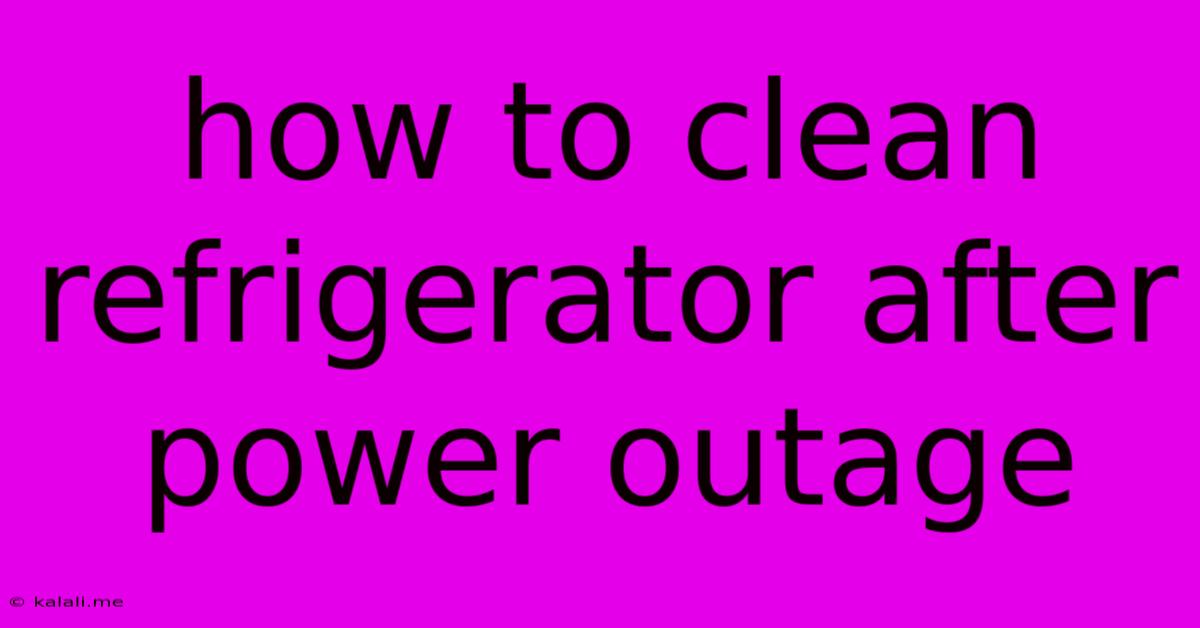How To Clean Refrigerator After Power Outage
Kalali
May 31, 2025 · 4 min read

Table of Contents
How to Clean Your Refrigerator After a Power Outage: A Step-by-Step Guide
A power outage can be a real inconvenience, and dealing with its aftermath on your refrigerator can be particularly unpleasant. Food spoilage is a major concern, but so is the potential for bacterial growth if proper cleaning isn't undertaken. This guide provides a thorough, step-by-step process for cleaning your refrigerator after a power outage, ensuring food safety and preventing unpleasant odors. This includes tips for preventing future issues and what to do with potentially spoiled food.
Assessing the Damage: What to Inspect First
Before you begin the deep clean, you must first assess the damage. How long was the power out? This is crucial in determining the safety of your food. Generally, food can safely remain in a refrigerator for about four hours without power. However, this timeframe can decrease in warmer temperatures. Inspect each item individually. Look, smell, and touch to determine if it's spoiled.
Discarding Spoiled Food: A Necessary Step
Discard any food that shows signs of spoilage. These signs include:
- Unpleasant odor: This is a clear indicator that something has gone bad. Trust your nose!
- Unusual texture: Changes in texture, such as slimy or sticky surfaces, indicate bacterial growth.
- Mold or discoloration: Visible mold is a definite sign of spoilage, as is unusual discoloration.
- Off-flavors: If something tastes or smells “off”, it’s best to discard it.
Pay close attention to perishable items such as:
- Dairy products: Milk, yogurt, cheese, and cream are particularly susceptible to spoilage.
- Meat and poultry: Raw or cooked meat should be discarded if it's been out of refrigeration for more than four hours.
- Seafood: Seafood spoils quickly and should be discarded if there is any doubt about its freshness.
- Leftovers: Leftovers are especially vulnerable as they may contain a variety of ingredients with varying spoilage rates.
Cleaning the Refrigerator Interior: A Deep Clean
After discarding spoiled food, it's time for a deep clean. This will remove any lingering bacteria and prevent future issues. Here’s how:
- Empty the refrigerator completely: Remove all remaining food items and shelves.
- Remove and clean the shelves and drawers: Wash them thoroughly with warm, soapy water. You can use a mild disinfectant, but avoid harsh chemicals that could leave behind a residue. Allow them to air dry completely.
- Wash the interior walls: Use a solution of warm water and mild dish soap to clean the interior walls, paying close attention to any spills or sticky residue.
- Tackle spills and sticky messes: For stubborn stains, let the soapy water sit for a few minutes before scrubbing gently. Baking soda paste can be very effective for removing stubborn stains.
- Disinfect thoroughly: Once cleaned, disinfect the interior with a solution of water and white vinegar (a natural disinfectant) or a food-safe disinfectant. Wipe down all surfaces thoroughly.
- Rinse and dry: Rinse everything thoroughly to remove all traces of soap and disinfectant, ensuring the refrigerator is completely dry before replacing the shelves and drawers.
- Deodorize: Place an open box of baking soda inside the refrigerator to absorb any lingering odors. You can also use activated charcoal for this purpose. Replace the baking soda every few months.
Cleaning the Refrigerator Exterior: Don't Forget the Outside!
While the interior is important, don’t forget the exterior! Wipe down the outside of the refrigerator with a damp cloth to remove any fingerprints, dust, or spills.
Preventing Future Issues: Proactive Steps
To prevent future problems after a power outage:
- Invest in a thermometer: A refrigerator thermometer will help you monitor the temperature and ensure your food remains safe.
- Keep your refrigerator properly maintained: Regularly clean your refrigerator to prevent bacteria buildup and ensure optimal performance.
- Consider a power backup: A generator or uninterruptible power supply (UPS) can help keep your refrigerator running during a power outage.
- Plan ahead: Have a plan in place for what to do with perishable foods during a power outage.
By following these steps, you can efficiently clean your refrigerator after a power outage, ensuring food safety and maintaining a fresh, clean environment. Remember, safety is paramount, and discarding spoiled food is critical to preventing illness.
Latest Posts
Latest Posts
-
Pa Que Quieres Saber Eso Jaja Saludos
Jun 02, 2025
-
Obi Snow White With The Red Hair
Jun 02, 2025
-
Should There Be A Full Stop After Colon And Comma
Jun 02, 2025
-
Can I Power A Device With Ac Power
Jun 02, 2025
-
Perlin Noise For Smoothing To Movement
Jun 02, 2025
Related Post
Thank you for visiting our website which covers about How To Clean Refrigerator After Power Outage . We hope the information provided has been useful to you. Feel free to contact us if you have any questions or need further assistance. See you next time and don't miss to bookmark.